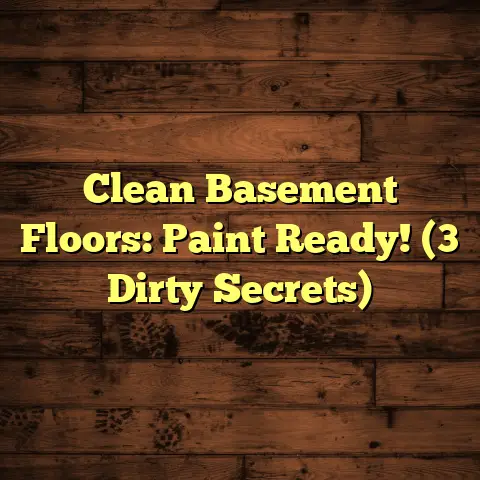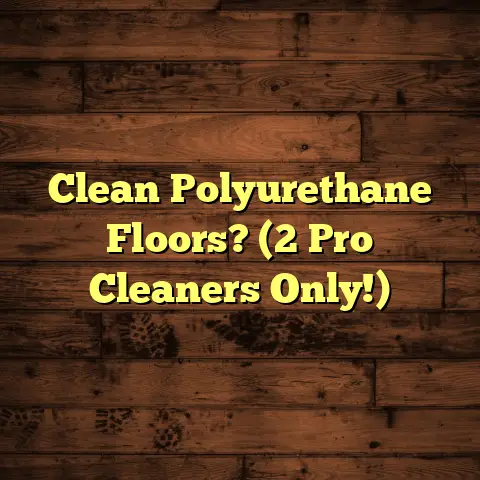Buff Wood Floors By Hand? (4 Polish Pro Tips!)
But let’s be real, keeping those floors looking their best can be a pain, and expensive!
That’s why I want to let you in on a little secret: you can achieve professional-looking results by buffing your wood floors by hand.
Think about it: the average cost to have a professional refinish your wood floors can range from $3 to $8 per square foot.
For a 1,000 square foot home, that’s $3,000 to $8,000!
You could save a significant chunk of change by taking the DIY route.
According to a recent survey by the National Association of Realtors, homes with hardwood floors sell for an average of 2.5% more than those without.
That’s a huge incentive to keep them in tip-top shape!
So, is buffing wood floors by hand worth the effort?
Absolutely!
It’s cost-effective, gives you control over the process, and it’s incredibly satisfying to see your hard work pay off.
Let’s dive in and I’ll show you how it’s done.
Section 1: Understanding Wood Floor Finishes
Before you grab a buffer and start polishing, it’s crucial to understand the type of finish on your wood floors.
Think of it like this: you wouldn’t use the same shampoo for oily hair as you would for dry hair, right?
The same principle applies to wood floor finishes.
There are several common types of finishes, each with its own characteristics and maintenance requirements:
Oil-Based Polyurethane: This is a durable, long-lasting finish that provides a warm, amber hue.
It’s resistant to scratches and water damage, but it can yellow over time.Water-Based Polyurethane: This is a more environmentally friendly option that dries quickly and doesn’t yellow as much as oil-based finishes.
It’s also lower in VOCs (volatile organic compounds), which means it has less of an odor.Penetrating Oil Finishes (like Tung Oil or Linseed Oil): These finishes penetrate the wood fibers, providing a natural look and feel.
They’re easy to repair, but they require more frequent maintenance.Varnish: A durable finish that offers good protection against scratches and moisture.
It can be applied in multiple coats for added durability.Lacquer: This finish dries quickly and provides a smooth, glossy surface.
However, it’s not as durable as polyurethane and is more susceptible to scratches.
The type of finish on your floor will affect the buffing process.
For example, floors with penetrating oil finishes may require a different type of buffing pad and cleaning solution than those with polyurethane finishes.
A little history lesson: Back in the day, wood floors were often finished with natural oils and waxes.
These finishes required regular maintenance and polishing to maintain their shine.
Over time, more durable finishes like polyurethane were developed, offering greater protection and requiring less upkeep.
How do you know what type of finish you have?
A simple test is to place a drop of water on the floor.
If it beads up, you likely have a polyurethane finish.
If it soaks in, you probably have a penetrating oil finish.
You can also consult your home’s records or contact a flooring professional for assistance.
Knowing your finish is half the battle!
Trust me, taking the time to identify it will save you headaches (and potentially costly mistakes) down the road.
Section 2: The Benefits of Buffing Wood Floors By Hand
Okay, let’s talk about why you should consider buffing your wood floors by hand.
I know, the thought of getting down on your hands and knees might not sound appealing, but hear me out.
Cost Savings: This is the big one!
As I mentioned earlier, hiring a professional can be expensive.
By doing it yourself, you’ll save hundreds, even thousands, of dollars.
You’re only paying for the materials and your time.Personal Satisfaction: There’s nothing quite like the feeling of accomplishment you get from tackling a DIY project.
Seeing your floors transform from dull to dazzling is incredibly rewarding.Control: When you hire a professional, you’re trusting them to do the job right.
But when you do it yourself, you have complete control over the process.
You can choose the products you want to use, the level of shine you want to achieve, and the pace at which you work.Environmental Impact: Many professional floor cleaning and refinishing services use harsh chemicals that can be harmful to the environment.
By buffing your floors by hand, you can choose eco-friendly cleaning solutions and reduce your carbon footprint.
Hand buffing allows for a more customized approach.
You can focus on areas that need extra attention, like high-traffic zones or areas with scratches.
You can also tailor your technique to the specific type of wood and finish you have.
I’ve talked to so many homeowners who were hesitant to try buffing their floors by hand, but were thrilled with the results.
One homeowner told me, “I was amazed at how easy it was!
My floors look like they were professionally done, and I saved a ton of money.”
Another said, “I love that I could use natural cleaning products and avoid the harsh chemicals that the professionals use.”
Don’t underestimate the power of DIY!
With a little elbow grease and the right knowledge, you can achieve stunning results and save a bundle.
Section 3: Essential Tools and Materials Needed for Hand Buffing
Alright, let’s get down to the nitty-gritty: what tools and materials do you need to buff your wood floors by hand?
Don’t worry, you don’t need a fancy industrial-strength buffer.
Here’s a comprehensive list:
- Buffing Pads: These are essential for polishing your floors.
You’ll need different types of pads for different stages of the process.- Coarse Pads: Used for removing old wax or finish.
- Medium Pads: Used for general cleaning and polishing.
- Fine Pads: Used for achieving a high-gloss shine.
- Buffing Machine (Optional but Recommended): While you can buff by hand with a pad and a lot of elbow grease, a buffing machine will make the job much easier and faster.
You can rent one from most hardware stores. - Cleaning Solution: Choose a pH-neutral cleaner specifically designed for wood floors.
Avoid harsh chemicals or abrasive cleaners. - Microfiber Mop or Cloths: These are great for cleaning and applying cleaning solutions.
- Vacuum Cleaner: To remove dust and debris before buffing.
- Spray Bottle: For applying cleaning solution.
- Protective Finish (Optional): After buffing, you may want to apply a protective finish to extend the life of your floors.
Where can you find these tools?
Local hardware stores, home improvement centers, and online retailers like Amazon are all great options.
Don’t be afraid to shop around for the best prices.
Cost-wise, renting a buffing machine will likely be your biggest expense, typically ranging from $30 to $50 per day.
Buffing pads are relatively inexpensive, usually costing a few dollars each.
Cleaning solutions can range from $10 to $30 per bottle.
Don’t skimp on quality!
Investing in durable tools and high-quality cleaning solutions will pay off in the long run.
A cheap buffing pad might fall apart mid-job, and a harsh cleaner could damage your floors.
DIY buffing tools are significantly more affordable than professional equipment.
A professional-grade floor buffer can cost thousands of dollars, while a DIY-friendly model can be rented for a fraction of the price.
Remember, you don’t need to break the bank to achieve professional-looking results.
With a little research and some smart shopping, you can gather all the necessary tools and materials without emptying your wallet.
Section 4: Step-by-Step Guide to Hand Buffing Wood Floors
Okay, here’s the moment you’ve been waiting for: the step-by-step guide to buffing your wood floors by hand.
I’m going to break it down into manageable phases to make it as easy as possible.
Phase 1: Preparation
Clear the Room: Remove all furniture, rugs, and other obstacles from the room.
This will give you plenty of space to work.Vacuum Thoroughly: Use a vacuum cleaner with a soft brush attachment to remove all dust, dirt, and debris from the floor.
Pay close attention to corners and edges.Clean the Floor: Use a pH-neutral wood floor cleaner and a microfiber mop to clean the floor.
Follow the manufacturer’s instructions carefully.
Make sure the floor is completely dry before proceeding to the next step.
Polish Pro Tip #2: The importance of cleaning your floor before buffing.
* I can’t stress this enough.
Buffing a dirty floor is like polishing a dirty car.
You’ll just grind the dirt into the finish, causing scratches and dullness.
A clean floor is essential for achieving a beautiful, long-lasting shine.
Phase 2: Buffing
- Attach the Appropriate Buffing Pad: Start with a medium-grit buffing pad.
If your floors are heavily soiled or have a lot of old wax buildup, you may need to start with a coarse-grit pad.
Polish Pro Tip #1: Choosing the right buffing pad for your floor type.
* This is crucial!
Using the wrong pad can damage your floor.
Always test the pad in an inconspicuous area first to make sure it doesn’t scratch the finish.
If you’re unsure, start with a finer grit pad and work your way up.
- Buff the Floor: If you’re using a buffing machine, start in a corner and work your way across the room in overlapping passes.
If you’re buffing by hand, use a circular motion and apply even pressure.
Polish Pro Tip #3: Techniques for buffing to achieve an even shine.
* The key is consistency.
Whether you’re using a machine or buffing by hand, maintain a consistent speed and pressure.
Overlapping your passes will help to ensure an even shine.
Don’t rush the process!
Take your time and focus on each area of the floor.
- Repeat as Needed: Depending on the condition of your floors, you may need to repeat the buffing process several times.
Change to a finer-grit pad with each pass to achieve a higher shine.
Phase 3: Finishing
-
Vacuum Again: After buffing, vacuum the floor again to remove any dust or debris created by the buffing process.
Apply a Protective Finish (Optional): If you want to extend the life of your floors and protect them from scratches and wear, you can apply a protective finish.
Choose a finish that is compatible with your existing floor finish.
Polish Pro Tip #4: How to apply a protective finish after buffing to extend the life of your floor.
* This is like putting a topcoat on your manicure.
It protects the underlying finish and helps it last longer.
Apply the finish in thin, even coats, following the manufacturer’s instructions carefully.
Allow the finish to dry completely before walking on the floor.
- Admire Your Work: Step back and admire your beautifully buffed wood floors!
You did it!
Safety Tips:
- Always wear eye protection and a dust mask when buffing.
- Keep children and pets away from the work area.
- Unplug the buffing machine when changing pads or making adjustments.
- Dispose of used buffing pads properly.
Remember, patience is key.
Don’t rush the process, and take breaks when needed.
With a little effort, you can achieve professional-looking results and save a lot of money.
Section 5: Maintaining Buffed Wood Floors
You’ve buffed your floors, they look amazing, but the job doesn’t end there.
Proper maintenance is crucial to keep them looking their best for years to come.
Here are some ongoing maintenance tips:
- Regular Cleaning: Sweep or vacuum your floors regularly to remove dust and debris.
Use a pH-neutral wood floor cleaner and a microfiber mop to clean spills and stains promptly. - Use Protective Mats: Place mats at entrances and in high-traffic areas to protect your floors from dirt and wear.
- Avoid Harsh Chemicals: Never use abrasive cleaners, bleach, or ammonia on your wood floors.
These can damage the finish and dull the shine. - Trim Pet’s Nails: Keep your pet’s nails trimmed to prevent scratches.
- Use Furniture Pads: Place felt pads under furniture legs to prevent scratches and dents.
Regular buffing can save you money in the long run.
By maintaining your floors properly, you can reduce the need for costly refinishing.
A light buffing every year or two can help to remove minor scratches and restore the shine.
How often should you buff your floors?
It depends on foot traffic and wear patterns.
High-traffic areas may need to be buffed more frequently than low-traffic areas.
I recommend inspecting your floors every few months and buffing them as needed.
Be proactive in your floor care!
Don’t wait until your floors look dull and worn to take action.
A little preventative maintenance can go a long way in preserving their beauty and extending their lifespan.
Conclusion
So, there you have it: a comprehensive guide to buffing your wood floors by hand.
I hope I’ve convinced you that it’s a cost-effective and rewarding way to maintain the beauty of your home.
Think about it: you’re saving money, you’re getting a workout, and you’re taking pride in your home.
What’s not to love?
Remember the four pro tips:
- Choose the right buffing pad for your floor type.
- Clean your floor thoroughly before buffing.
- Use consistent techniques to achieve an even shine.
- Apply a protective finish to extend the life of your floor.
Don’t be afraid to take the plunge!
Buffing your wood floors by hand is easier than you think.
With a little preparation, the right tools, and a bit of elbow grease, you can achieve professional-looking results and save a ton of money.
I encourage you to give it a try.
Maintain your wood floors, enjoy their beauty, and take pride in the fact that you did it yourself.
You’ve got this!





